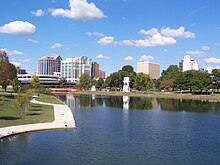


The following is a list of the largest metropolitan areas in the US state of Alabama. [1] As of 2020, Birmingham has the biggest metropolitan area and urban area in Alabama followed by Huntsville. The table data is from the US census in 2010 and 2020. [2] [3]
| Rank | Metropolitan Area | Population (2020 census) | Population (2010 census) |
|---|---|---|---|
| 1 | Birmingham | 1,091,921 | 1,061,024 |
| 2 | Huntsville | 481,681 | 417,593 |
| 3 | Mobile | 428,692 | 430,573 |
| 4 | Montgomery | 372,583 | 374,536 |
| 5 | Tuscaloosa | 253,211 | 239,207 |
| 6 | Daphne-Fairhope-Foley | 229,287 | 182,265 |
| 7 | Auburn | 166,831 | 140,247 |
| 8 | Decatur | 152,740 | 152,829 |
| 9 | Dothan | 150,214 | 145,639 |
| 10 | Florence-Muscle Shoals | 148,779 | 147,137 |
| 11 | Anniston-Oxford | 113,469 | 118,572 |
| 12 | Gadsden | 102,371 | 104,430 |
| Rank | Combined Statistical area | Population (2020 census) | Population (2010 census) |
|---|---|---|---|
| 1 | Birmingham-Hoover-Talladega | 1,361,033 | 1,302,283 |
| 2 | Huntsville-Decatur-Albertville | 852,756 | 664,441 |
| 3 | Mobile-Daphne-Fairhope | 646,576 | 595,257 |
| 4 | Columbus-Auburn-Opelika | 563,967 | 469,327 |
| 5 | Dothan-Enterprise-Ozark | 253,798 | 245,838 |